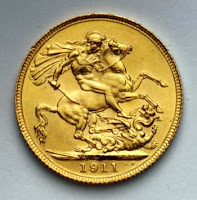In the 16th century the goldsmith-bankers began to accept deposits, make loans and transfer funds. They also gave receipts for cash, that is to say gold coins, deposited with them. These receipts, known as “running cash notes”, were made out in the name of the depositor and promised to pay him on demand.
Many also carried the words "or bearer" after the name of the depositor, which allowed them to circulate in a limited way. The similar phrase "I promise to pay the bearer on demand the sum of ...." still appears on British banknotes today.
At that time, a member of the public could exchange one of our banknotes for gold to the same value. For example, a £5 note could be exchanged for five gold coins, called sovereigns
The £10 note was first issued by the Bank of England during the Seven Year’s War (1755-1764) to help maintain more of its gold reserves. The idea was for people to cash in smaller denominations of money in exchange for gold, thus easing the strain on the bank.
Ten shilling (50p) note.
Design first issued in November 1928. As to coin, the collection includes a representative selection of the regal coinage issued by the Royal Mint from 1694, the year of the Bank's foundation, and comprehensively covers the Bank's late 18th and early 19th century issues of Bank of England dollars and tokens.
1911 Sovereign (gold coin with a face value of £1). Reverse with St George and the dragon design.
The promissory clause printed on the banknotes i.e., "I promise to pay the bearer an amount of X" is a statement which means that the banknote is a legal tender for X amount. The obligation on the part of the Bank is to exchange a banknote for COINS of an equivalent amount.
Series C: Issued 1964

Having understood the features of sercurity and promissory clause enables me to have a brief idea of what typorgraphy could be displayed within the development stages of my note. But also questioning if it is appropirate and could there be a newly introduced condtions in the future. Seeing as people tend to use their debit cards as much as notes.





No comments:
Post a Comment